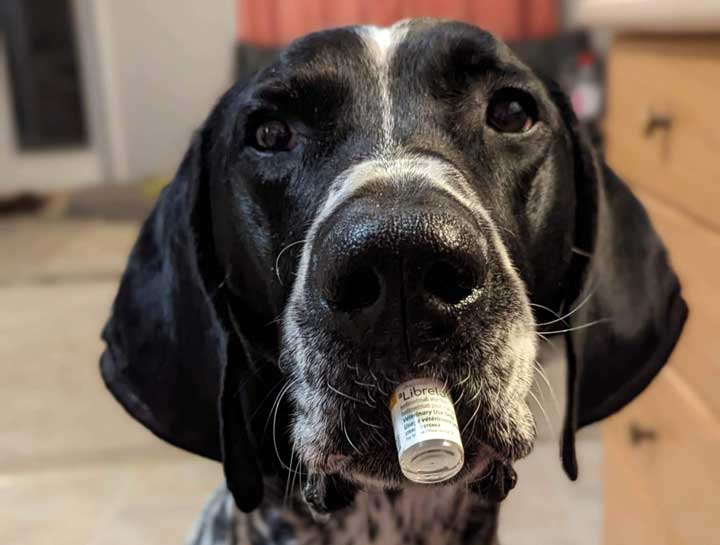Pain Management
Treating a patient who cannot tell you where it hurts is one of the toughest aspects of being a veterinarian. Animals feel pain just like us and so we understand that chronic pain impacts them physically and emotionally. Osteoarthritis is the most common cause of chronic pain in dogs, but the signs can be subtle and may be mistakenly attributed to the normal aging process. The first step is recognizing what pain looks like.
We want to assist you in ensuring that your pet has the best quality of life by using a combination of pain management, nutrition, lifestyle modification, and rehabilitation as soon as signs of progressive joint disease are exhibited:
Pain Management
There are many factors involved in the pain pathway and perception of pain. A multimodal approach is required to target the peripheral and central nervous system
- Non-steroidal Anti-inflammatories (NSAIDs) alleviate pain by treating the inflammation associated with damaged tissue. In other words, they target the peripheral nervous system. NSAIDs currently remain the first line in pain management for orthopedic discomfort, based on the high level of evidence for their efficacy. We currently have a variety of NSAIDs approved for use in dogs and choosing the most effective one is very individual for each patient. A positive response to the drug should be seen within 2 weeks, therefore if no improvement is seen, it may be worth trying a different NSAID before considering adding another pain medication. Daily administration is recommended because studies have found there is a cumulative therapeutic effect. In some patients it is possible to wean down to the lowest effective dose or use as needed, however, if a setback in symptoms is seen, full daily dosing should be reinstated. Adverse events with NSAID use are uncommon, especially when we consider the number of patients using these medications. Potential adverse events include gastrointestinal ulceration, kidney toxicity, and idiosyncratic liver damage that is typically seen within 2-4 weeks of starting an NSAID. We can minimize adverse effects by avoiding use in patients with known kidney and/or liver disease and by performing monitoring bloodwork to regularly assess kidney and liver health.
- Gabapentin blocks channels on nerves in the central nervous system which decreases the transmission of pain signals up to the brain. Once pain reaches the spinal cord, it can be difficult to control - The nerves that previously transmitted pain can become the source of pain (neuropathic pain). Gabapentin can be an adjunct to pain management by decreasing pain in the spinal cord. Adverse effects are minimal and include sedation and incoordination. These can be avoided with a gradual dose increase. In some patients, sedation at night can be helpful to achieve much-needed rest.
- Amantadine inhibits receptors in the spinal cord that cause maladaptive changes to nerves due to repeated signals of pain from the peripheral nerves (central sensitization). This lowers the pain thresholds, meaning pain that was previously perceived as mild, now feels amplified. Amantadine is an adjunct to pain management just like Gabapentin. Adverse effects include stomach upset and it should be used with caution in patients with kidney disease and seizures.
- Tramadol is metabolized into many metabolites that affect the same receptors as opioids (ie: morphine) but has a weaker effect and variable pain control. Repeated dosing may result in reduced effect but for some individuals, it can be used as an adjunct pain medication. Adverse effects include sedation, and stomach upset and should be used with caution in patients with severe kidney and liver disease and seizures.
- Cartrophen (pentosan polysulfate sodium) is a sulfated sugar of plant origin that has been shown to stimulate cartilage production, improve joint fluid quality, and decrease inflammation within the joint. It is an injectable given under the skin once weekly for four weeks and then at an interval that controls symptoms, typically monthly. It can be administered in the hospital or at home by pet owners.
- Cannibis products (CBD and THC) have been shown to alleviate orthopedic pain in humans. The prospect of its use for pain control in our furry friends is promising and has emerged as a promising field of research. At this time, there are no cannabinoid-containing products available for veterinary use in Canada (this does not include hemp products). Veterinarians can not legally prescribe cannabinoid products for your pet, we can provide guidelines that ensure safe use if a client elects to pursue this.
Nutrition
As the incidence of obesity rises in our pets, we need to recognize obesity as a disease that dramatically affects the quality and duration of life. Carrying a few extra pounds places strain on joints and causes fat cells to produce harmful chemicals that damage even non-weight-bearing joints. There have been many studies that have shown weight loss alone can reduce symptoms of osteoarthritis - in some cases, the effect of weight loss is equivalent to the use of anti-inflammatory medications on weight bearing. For breeds prone to joint diseases such as hip dysplasia, obesity can significantly reduce the age of onset for osteoarthritis. Because weight management is so important, we work with our clients to find the right food to suit budgets and lifestyles, while maintaining optimal nutrition. Our skilled senior registered veterinary technician, Stacy, can provide customized nutritional counseling for your pet and ongoing support to our clients. A good weight loss plan should include:
- Appropriate caloric intake for weight loss - We need to explore calorie consumption in a typical day and let’s be honest, it needs to include ALL treats. We need to be very precise with our daily amount - even just a few extra kibbles can add up quickly. If the current diet being fed is calorie-dense, the volume fed to achieve weight loss may be too small, resulting in hunger and inadequate nutrition. Therapeutic weight loss diets have many advantages - They are low in calories, help to encourage muscle mass, increase metabolism, and help pets to feel full.
- Accountability - There is a reason why programs like Weight Watchers work. Weight loss is hard, sometimes we go off track or become frustrated by not seeing immediate results and we need someone supporting us. We have regular pet weight updates to support our clients and adjust the plan if things aren’t progressing as we would expect.
- Sustainability - Yo-yo dieting for pets is a real thing. We must ensure that our patients don’t fall off the wagon once they have reached their weight loss goal. We teach our clients how to assess body condition scores and closely monitor weight at home. In theory, calories can be increased to maintenance level but some of our patients need to stay on a weight loss diet indefinitely.
- Dietary supplements containing glucosamine, chondroitin, and omega-3 fatty acids can help with joint health, decrease inflammation associated with arthritis, and reduce the amount of NSAIDs needed. With many joint health products, it will take up to 2 months to appreciate improvement, therefore, we recommend these products long term. Given the large selection of products, it can be difficult to know which are safe and effective. Supplements are not necessarily subjected to quality control and may not contain the ingredients or concentrations listed on the label. When choosing a product look for a more established company, a third-party verification of quality and safety, and studies showing efficacy. Prescription joint diets have the advantage of containing many of these joint health additives, as well as therapeutic levels of omega 3 fatty acids (EPA and DHA) with studies to support the benefit to arthritic patients. If supplementing with omega 3s alone, the most potent source of EPA and DHA is fish oil which needs to be protected from light. Flaxseed, linseed, or canola oil is not a good source for dogs. Human brands such as Nordic Natural and Weber products can be used but be sure to avoid products containing Vitamin D and other flavourings.
Lifestyle Modification
Regular exercise and activity modification are essential in minimizing weight gain, joint stiffness, muscle loss, and decline of function. An ideal exercise program for dogs with osteoarthritis is a regular, low-impact exercise that is controlled. More benefits are seen with smaller doses of daily exercises rather than long irregular sessions. Low-impact exercises such as swimming, will reduce the force on arthritic joints. High acceleration exercises such as running or jumping amplify the impact on joints and should be avoided. Controlled exercises such as leash walks allow an owner to be the voice of reason and avoid activities that their pet may pay for the next day. Home environment modification refers to configuring a home to accommodate a dog with osteoarthritis. Traction when standing up can be provided by non-slip booties or non-slip runners, especially directly under/around dog beds. Stairs can help provide an active range of motion and improve strengthening and foot placement but they need to be non-slip. Going downstairs places a lot of force on front limbs and gravity makes a slow descent difficult so assistance using a sling or harness may be needed. The bedding should be supportive and placed in a warm area. Pulsed electromagnetic field beds such as the Loop Lounge from https://assisianimalhealth.com/pet-owners/ can provide non-pharmaceutical pain relief. Nails should be kept short to prevent slipping and arthritis from developing in the toes. Dogs with long feathers between pads should have this hair trimmed to help with traction. Raised feeding stations to the level of the shoulders can help with shifting weight onto painful joints when bending down to eat.
Rehabilitation
A certified canine rehabilitation practitioner (CCRP) is vital to improving the quality of life in our osteoarthritic patients by reducing pain, improving mobility, and improving strength and endurance. Aquatic therapy, therapeutic exercises, and equipment such as a laser or ultrasound are incorporated into a comprehensive plan to reduce pain. Some patients may be able to reduce or discontinue their daily pain medication. Targeted exercises will improve the joint’s ability to move through its normal range of motion and, therefore, improve function. Increased strength of muscles and ligaments surrounding affected joints will help to stabilize joints and improve the way arthritic dogs move, which means less pain and less chance of compensatory injuries. This all leads to improved endurance; those daily activities that were a challenge previously may now be pain-free. Who doesn’t want to see the hands of time turn back for their senior dog?

